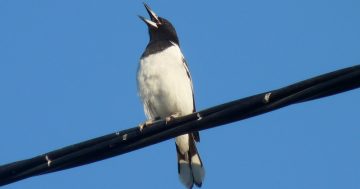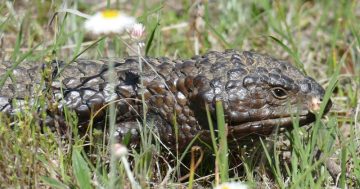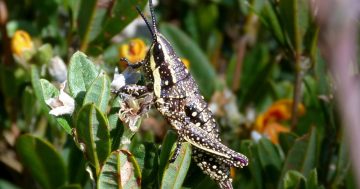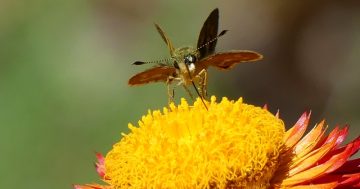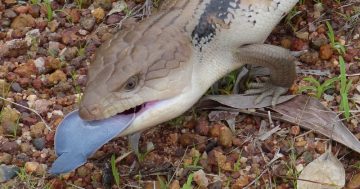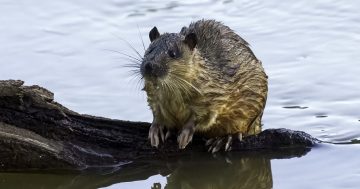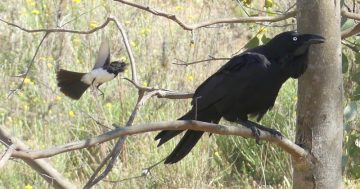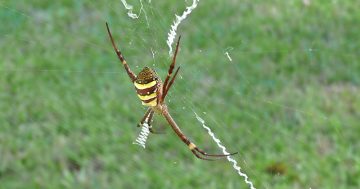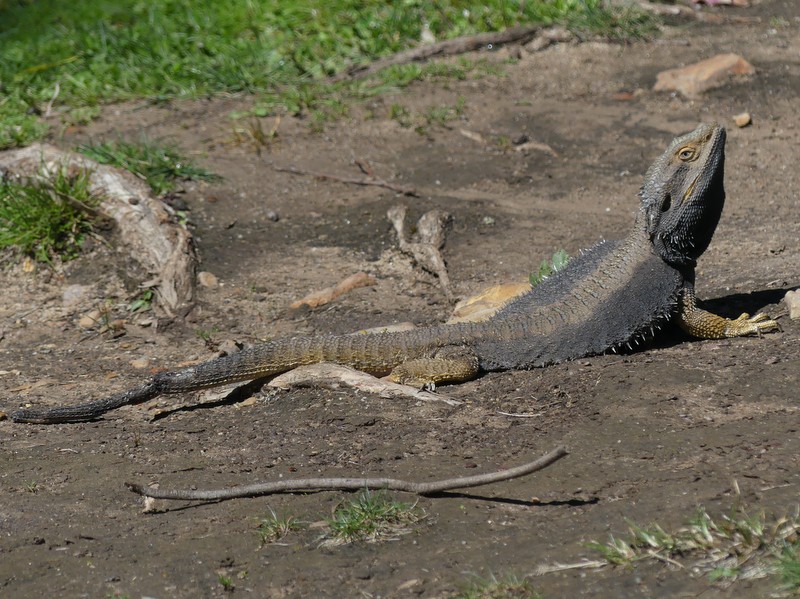
Bearded Dragon in the National Botanic Gardens. It has flattened itself and turned side-on to the sun, as well as darkening its skin to absorb more heat. Photo: Ian Fraser.
Here be dragons? No, really!
As the days reluctantly start to warm up, the reptiles emerge in Canberra, among them a few species of the often quite dramatic dragon lizards, which are always a source of great pleasure to me.
This group of lizards is found throughout Australia and across Asia and Africa; I say ‘lizards’, but in fact, they are such an ancient group that they are less closely related to other lizards than snakes are.
A couple of large and quite familiar dragon species are easily seen in the warm months in Canberra. The Eastern Bearded Dragon can be found on any of the Canberra hills and open spaces and is often encountered sitting on a stump or fence post waiting for passing insects.
If approached, it does its best to look fierce by puffing itself up, especially its fleshy ‘beard’, to look bigger and shows its impressive yellow mouth while huffing and puffing. It can be over 50 cm long, so this display can be quite intimidating if you don’t know how shy they really are.
If you get closer, they will try to keep a tree trunk between you and them, sidling around as you circle them. Finally, if it all gets too much, they will explode into action, racing off through the undergrowth on long, strong legs.
They can change colour quite impressively too. If they’re warming themselves to gain energy, they darken their skin with extra melanin, turning almost black to absorb more heat.
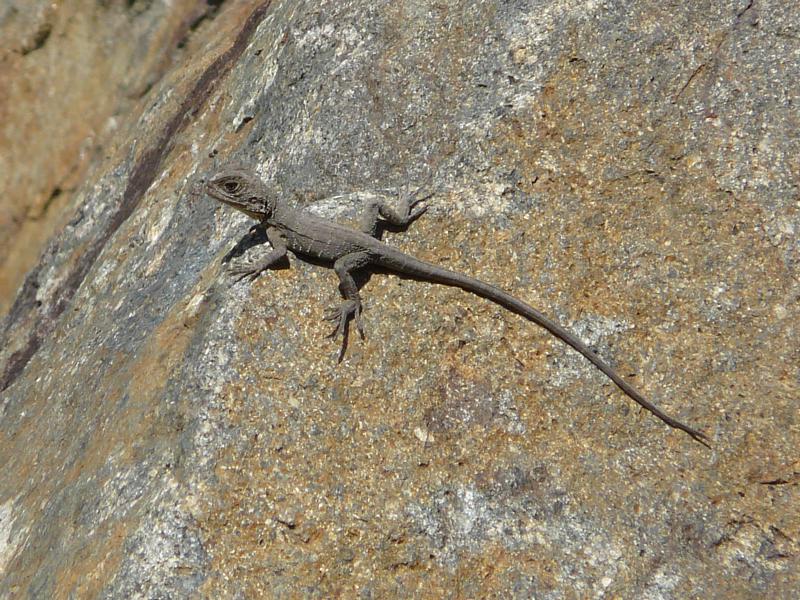
Young Eastern Water Dragons can be found on almost any rock in the Botanic Gardens. They need to be constantly alert for danger, including from adult dragons. Photo: Ian Fraser.
A dragon can easily be distinguished from the other common local lizards, the skinks (which include bluetongues and shinglebacks as well as many smaller ones) by their spiky scales and their posture, standing up on strong legs, not lying flat on the ground. Unlike skinks, they can’t drop and regrow their tails.
A less obvious difference is in their teeth.
Unlike other reptiles, but like fish and frogs, they don’t have tooth sockets; the base of the tooth fuses to the surface of the jaw bone. This means their teeth break easily, but don’t be fooled, they work perfectly well! On more than one occasion, while handling beardies carelessly, I’ve quite deservedly received some significant lacerations from their triangular teeth.
At this time of year, they will be preparing to lay up to 30 eggs buried in the soil; often, they’ll lay a second clutch in summer.
However, perhaps the most familiar Canberra dragons are the Eastern (or Gippsland) Water Dragons, which have made the National Botanic Gardens their own.
Their ancestors lived along the Molonglo River until it was flooded to make Lake Burley Griffin in 1964. Some of them were pushed by rising waters up Sullivans Creek and thence into the developing gardens with ponds that suited them well.
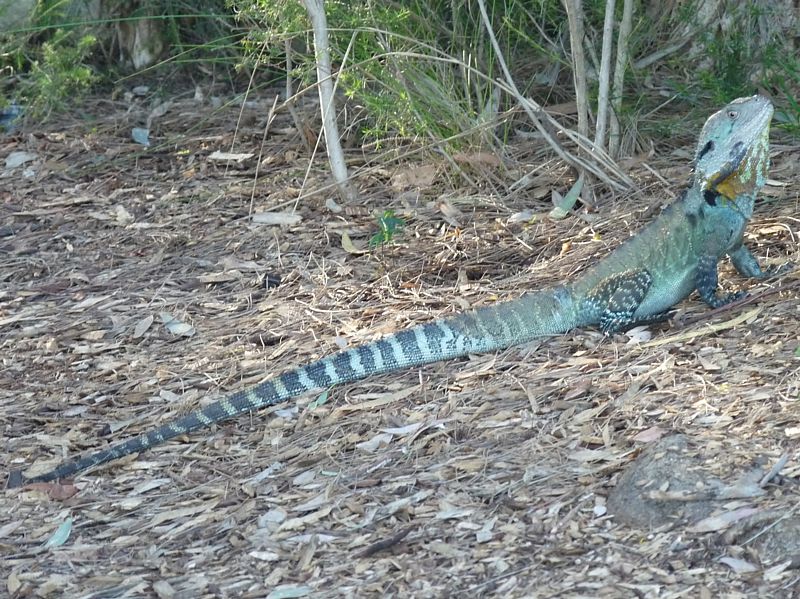
In summer, the big male Water Dragons become very colourful to impress the females and intimidate males. Photo: Ian Fraser.
In summer, the big males, nearly a metre long, take on spectacular colours, especially blue-green and brick red. They display to defend their territory. The swarms of plain-coloured baby water dragons, found wherever there are rocks in the gardens, tell us that the population is a healthy one.
These babies don’t have it easy, however, making handy snacks for snakes, birds (including kookaburras), and their own aunts and uncles. This is why water dragons have large clutches of about 20 soft-shelled buried eggs to allow for heavy losses of youngsters.
Water dragons are voracious hunters with very broad diets, including insects and crayfish, frogs and tadpoles, ducklings, small mammals and lizards, as well as berries and fruits.
They are comfortable on land where they run very fast, including on their hind legs, in the water where they can stay submerged for up to two hours, and in trees where they lie along branches over water, ready to drop in if disturbed.
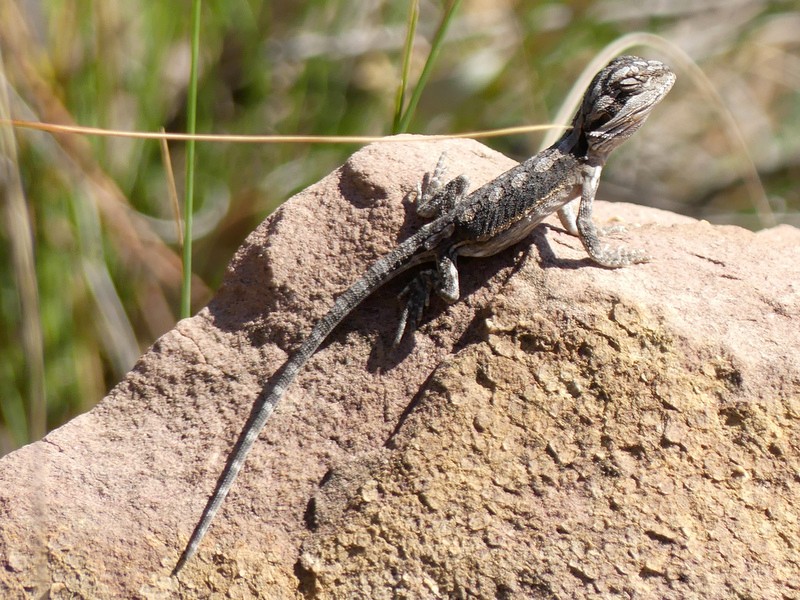
Jacky Lizard sunning on Black Mountain. Photo: Ian Fraser.
Probably as common as Bearded Dragons, but smaller and less obvious, are the little Jacky Lizards or Tree Dragons, which can be found on all the Canberra hills and in the ranges.
Unlike the beardies, which are happy in open country, the Tree Dragons like a dense understorey to hide in. They too climb to a suitable perch from which to wait for passing insects or bask on rocks or logs where their mottled pattern gives them excellent camouflage.
Our dragons may not be as spectacular as those of Game of Thrones or Tolkien, but they make much better neighbours! Keep an eye out for them this summer.
Ian Fraser is a Canberra naturalist, conservationist and author. He has written on all aspects of natural history, advised the ACT government on biodiversity and published multiple guides to the region’s flora and fauna.












